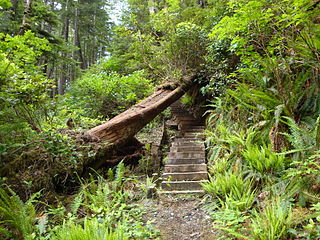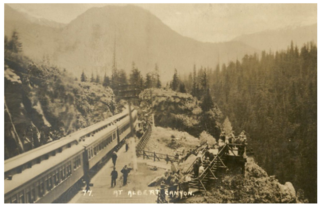Related Research Articles

Rogers Pass is a high mountain pass through the Selkirk Mountains of British Columbia, but the term also includes the approaches used by the Canadian Pacific Railway (CP) and the Trans-Canada Highway. In the heart of Glacier National Park, this tourism destination since 1886 is a National Historic Site.
Union Bay is south of Hart Creek on the east coast of central Vancouver Island, British Columbia. This Comox Valley community on BC Highway 19A is by road about 93 kilometres (58 mi) north of Nanaimo, and 14 kilometres (9 mi) south of Courtenay.
Roosville is a small farming community immediately north of the Canada–United States border in the East Kootenay region of southeastern British Columbia. On BC Highway 93, the locality is east of Lake Koocanusa, at the southeast corner of Tobacco Plains Indian Reserve No. 2.

Cape Scott Provincial Park extends from Shushartie in the east, then westward around Cape Scott and south to San Josef Bay. This coastline comprises the northern tip of Vancouver Island, British Columbia. The 22,294-hectare (55,090-acre) provincial park is about 563 km (350 mi) northwest of Victoria.
Holberg is a former ferry terminal about 35 kilometres (22 mi) from the northwest tip of Vancouver Island, British Columbia. This unincorporated community is at the head of Holberg Inlet, which forms the western arm of Quatsino Sound.
Winlaw is an unincorporated community adjacent to Winlaw Creek on the east side of the Slocan River in the West Kootenay region of southeastern British Columbia. The locality is on BC Highway 6 about 20 kilometres (12 mi) south of Slocan, and 49 kilometres (30 mi) north of Castlegar.
Brookmere is an unincorporated community adjacent to Brook Creek in the Nicola region of southern British Columbia. The former railway town, on Coldwater Rd, is by road about 44 kilometres (27 mi) south of Merritt.

Glacier, which once comprised small communities, is on the western approach to Rogers Pass in southeastern British Columbia. The name derives from the Great Glacier, which in the 1880s was just over a mile from the original train station.

Albert Canyon is about 32 kilometres (20 mi) east of Revelstoke in southeastern British Columbia. The former community no longer exists, but the Canyon Hot Springs Resort borders to its north, both immediately southwest of the Tangier River confluence with the Illecillewaet River.
Cody is at the confluence of Cody Creek into Carpenter Creek in the West Kootenay region of southeastern British Columbia. The ghost town, about one kilometre east of Sandon, lies off BC Highway 31A. By road, the former mining community is about 15 kilometres (9 mi) east of New Denver and 44 kilometres (27 mi) west of Kaslo.
Trout Lake is an unincorporated community in the West Kootenay region of southeastern British Columbia. The former steamboat landing is at the north end of Trout Lake. The locality, on BC Highway 31, is by road about 177 kilometres (110 mi) north of Nelson and 90 kilometres (56 mi) by road and ferry southeast of Revelstoke.
Wynndel is an unincorporated community adjacent to Duck Creek, east of the Kootenay River, in the West Kootenay region of southeastern British Columbia. The locality, on BC Highway 3A, is by road about 11 kilometres (7 mi) north of Creston and 128 kilometres (80 mi) southeast of Nelson.
Thrums is an unincorporated community on the northwest shore of the Kootenay River in the West Kootenay region of southeastern British Columbia. The location, on BC Highway 3A, is by road about 11 kilometres (7 mi) northeast of Castlegar, and 33 kilometres (21 mi) southwest of Nelson.
Vallican is an unincorporated community on the west side of the Slocan River in the West Kootenay region of southeastern British Columbia. At the mouth of the Little Slocan River, the locality formerly spanned both sides of the Slocan River. The rural neighbourhood is off BC Highway 6 about 30 kilometres (19 mi) south of Slocan, and 39 kilometres (24 mi) north of Castlegar.
Johnsons Landing is an unincorporated community in the West Kootenay region of southeastern British Columbia. The former steamboat landing comprises scattered rural properties adjacent to the mouth of Gar Creek. To the north is Gardner Creek and to the south is Fry Creek, the three creek mouths on the northeast shore of Kootenay Lake. The locality, via BC Highway 31 and Argenta Rd, is about 121 kilometres (75 mi) northeast of Nelson.
Kildonan is an unincorporated community in the Alberni Inlet-Barkley Sound region of the west coast of southern Vancouver Island, British Columbia. The former steamboat landing and ferry dock is on the east shore of Uchuchklesit Inlet, which branches northwest of the lower reaches of Alberni Inlet. Adjacent to Pacific Rim National Park Reserve, the locality is by road and ferry about 120 kilometres (75 mi) southwest of Port Alberni.

Parson is an unincorporated community on the east shore of the Columbia River, in the Columbia Valley region of southeastern British Columbia. The locality, on BC Highway 95, is by road about 212 kilometres (132 mi) north of Cranbrook and 35 kilometres (22 mi) southeast of Golden.
Harry Bruce Johnston was a Canadian politician, who served in the Legislative Assembly of British Columbia.
Beavermouth is about 43 kilometres (27 mi) west of Golden, and about 32 kilometres (20 mi) east of the mid-point of the Connaught Tunnel beneath Rogers Pass, in southeastern British Columbia. At the mouth of the Beaver River, the train station was called Beavermouth, but the adjacent community, which no longer exists, was known as Beaver or Beaver Mouth. Nowadays, the closest road access is to the nearby Kinbasket Lake Resort.
Strandby is adjacent to the mouth of the Strandby River at the west end of Shuttleworth Bight, near the northeastern extremity of Vancouver Island, British Columbia.
References
- Paterson, T.W.; Basque, G. (1999). Ghost Towns & Mining Camps of Vancouver Island. Sunfire Publications. ISBN 1-895811-80-5.
Coordinates: 50°51′15″N127°51′15″W / 50.85417°N 127.85417°W